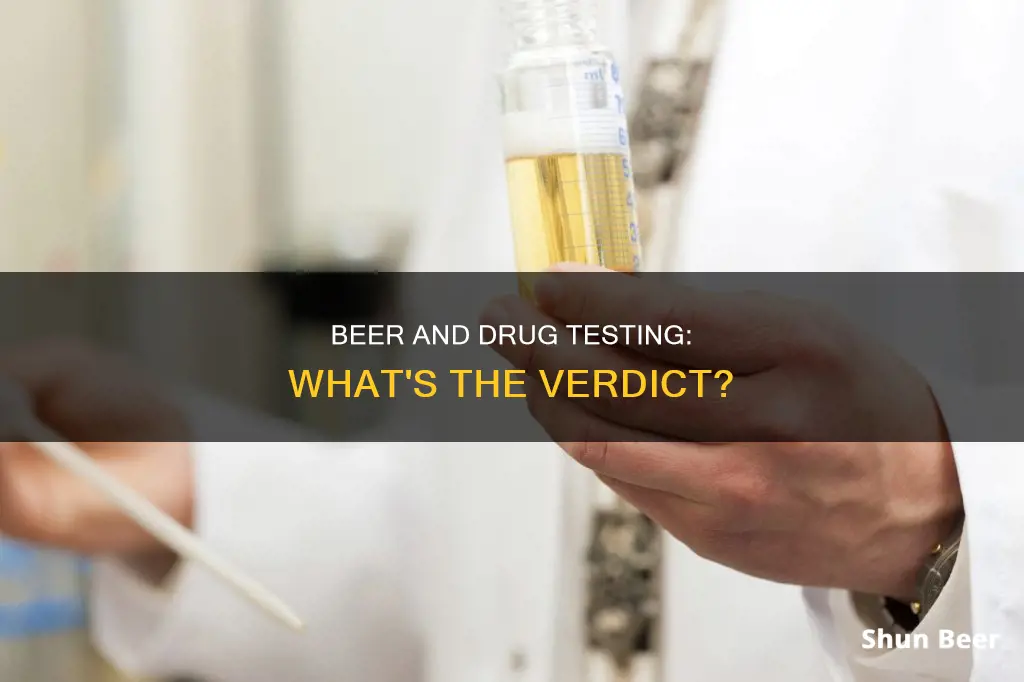
Whether or not you can drink a beer before a drug test depends on several factors, including the type of test, the amount of alcohol consumed, and individual characteristics. While standard drug tests typically do not include alcohol, some employers include it in their drug-free workplace policies, and it can be detected in blood, urine, saliva, hair, breath, and sweat tests. The detection window for alcohol varies depending on the test and individual factors, but it generally ranges from 12 to 48 hours. Therefore, drinking a beer the night before a drug test may or may not be detectable, depending on these variables.
| Characteristics | Values |
|---|---|
| Can alcohol be detected in a blood test? | Yes, for up to 28 days. |
| Can alcohol be detected in a urine test? | Yes, within an hour of consumption and for up to 12 hours. |
| Can alcohol be detected in a saliva test? | Yes, but only for a few hours. |
| Can alcohol be detected in a hair test? | Yes, but only for alcohol consumed in the last six months. |
| Can alcohol cause a false positive? | Yes, alcohol can interfere with the accuracy of a test and cause false positives. |
| Can alcohol make a test invalid? | Yes, heavy intoxication can make it difficult to provide an adequate sample. |
| What factors influence the presence of alcohol? | Amount consumed, rate of breakdown in the body, type of test, gender, age, weight, food intake, medications, and more. |
What You'll Learn
- Alcohol may show up in a blood test for weeks after drinking
- Urine tests can detect alcohol in less than an hour and it peaks within 5.5 hours
- Saliva tests can only detect alcohol for a few hours after consumption
- Hair tests are rare but can detect alcohol from six months ago
- Factors like the amount consumed, body weight, and gender can influence test accuracy

Alcohol may show up in a blood test for weeks after drinking
Drinking alcohol before a drug test is not recommended, as it can interfere with the accuracy of the test and even cause the test to be invalid. While there are no restrictions on consuming alcohol before a drug test, it is important to understand how alcohol can impact the test results.
The detection window for alcohol in the blood can vary depending on the specific test used. A standard blood alcohol concentration (BAC) test can detect alcohol in the blood for up to 12 hours after drinking. However, other blood tests, such as the Carbohydrate-Deficient Transferrin (CDT) test, can detect heavy alcohol use for up to 2 to 3 weeks. These tests look for substances that remain in the blood for longer periods after drinking.
It is important to note that the detection time can be influenced by various factors, including the amount of alcohol consumed, individual metabolism, gender, age, weight, and health conditions. These factors can impact how quickly alcohol is metabolized and eliminated from the body.
In summary, while alcohol may show up in a blood test for weeks after drinking, the specific detection time depends on the type of test and individual factors. It is always advisable to be honest with the person administering the test if you have consumed alcohol recently, as this can help ensure accurate results and avoid any potential issues.
Topsy Beer: Brewing Process and Science Explained
You may want to see also

Urine tests can detect alcohol in less than an hour and it peaks within 5.5 hours
Urine tests are a common method for assessing alcohol consumption. These tests can identify the presence of alcohol or its metabolites, which are by-products produced during the metabolization of alcohol by the liver. The detection window for alcohol in urine tests varies depending on the type of test and other factors.
Urine tests can detect alcohol in less than an hour after consumption, and its concentration peaks within 5.5 hours. This means that even if you have only had one drink, it is possible that a urine test will detect it within this timeframe. The detection window can also be influenced by factors such as the amount and frequency of alcohol consumed, individual metabolic rates, and the presence of certain medications or products containing alcohol.
The standard ethanol test can detect alcohol in the urine for up to 12 hours post-consumption. However, more sensitive tests, such as the Ethyl Glucuronide (EtG) and Ethyl Sulfate (EtS) tests, can detect alcohol intake for a much longer period. EtG tests can detect alcohol within approximately 80 hours of intake, while EtS tests have a detection window of up to 36 hours.
It is important to note that urine tests may not always be accurate and can result in false positives or false negatives. The accuracy of the test depends on various factors, including the type of test, the individual's metabolism, and the presence of other substances or medications.
If you are concerned about an upcoming drug test, it is best to avoid consuming alcohol for at least a few days beforehand to ensure that it does not affect your results.
Lactic Acidosis in Beer: Lab Work Indicators
You may want to see also

Saliva tests can only detect alcohol for a few hours after consumption
Saliva tests are one of the most common methods to detect alcohol consumption. When alcohol is ingested, it enters the bloodstream and is carried throughout the body, leaving traces in the form of metabolites. These indicators of alcohol consumption are detectable in an individual's saliva for about 12 to 24 hours after alcohol has been ingested. After 24 hours, alcohol is typically sufficiently metabolized and is no longer detectable in the saliva. This makes saliva testing a highly accurate way to test for very recent alcohol use.
Saliva tests are often used in situations where it is necessary to determine if alcohol consumption played a part in a recent incident or accident. For example, if someone is pulled over for suspected drunk driving, a saliva test can be administered on the spot to determine if they have been drinking. Similarly, if someone is involved in a workplace accident, a saliva test can be used to determine if alcohol was a contributing factor.
The detection window for saliva tests is shorter than that of other tests such as urine or blood tests. Urine tests can detect alcohol for up to 72 hours after consumption, while blood tests can detect alcohol for up to 28 days. However, saliva tests are advantageous because they are non-intrusive, easy to obtain, and provide results almost immediately.
It is important to note that the detection time for alcohol in saliva can vary depending on various factors such as age, body mass, metabolism, and health conditions. Additionally, the type of alcohol and the amount consumed can also impact the detection time. For example, liquors and craft beers have a higher percentage of alcohol by volume, which may result in a longer detection time.
In conclusion, saliva tests are a reliable and accurate method for detecting alcohol consumption within a few hours to a day after ingestion. However, the detection time can vary depending on individual factors and the specific circumstances of consumption.
Beer and Pfizer: Safe Drinking After the Vaccine
You may want to see also

Hair tests are rare but can detect alcohol from six months ago
While drinking alcohol is not illegal, it is natural to wonder if it could affect the outcome of an upcoming drug test. The answer is yes, alcohol can interfere with drug test results, and in some cases, even cause the test to be invalid. If you are due to take a drug test, it is best to refrain from drinking alcohol.
Hair tests are rare, but they can detect alcohol consumption from up to six months ago. This is because alcohol markers such as Fatty Acid Ethyl Esters (FAEEs) and Ethyl Glucuronide (EtG) can be absorbed and bound into the hair strand as it grows. EtG is a direct marker of alcohol consumption and is only present when a person has consumed alcohol or has increased blood alcohol levels. It is formed in the liver and deposited into the hair through sweat.
Hair alcohol tests are considered very accurate, but they are not infallible. Cosmetic hair treatments like bleaching, perming, and styling products can interfere with the results. Alcohol-based perfumes can also skew the results. Testers will ask about your cosmetic and hair care practices to determine if there could be an issue with the test results.
Hair samples are typically taken from the head, but they can also be taken from chest hair, armpit hair, or groin hair. Approximately 200 strands of hair are required for testing, and the strands will be 3 or 6 cm long, depending on the time period being tested for. For example, 3 cm of hair will cover a 3-month period.
Hair alcohol tests are often used to determine alcohol abuse or abstinence. They can also indicate whether a person has been drinking socially, recreationally, or infrequently. The test can usually detect alcohol use 1 to 6 months later, and in some cases, even longer.
Old Beer: Is It Safe to Drink After Four Months?
You may want to see also

Factors like the amount consumed, body weight, and gender can influence test accuracy
The amount of alcohol consumed, body weight, and gender can all influence the accuracy of a drug test.
Amount Consumed
The more alcohol consumed, the longer it takes for the body to metabolize it. Drinking quickly can overwhelm the liver, leaving more alcohol in the body for a longer period. Alcohol appears in urine within an hour of consumption and peaks within 5.5 hours. Binge drinking or chronic heavy drinking can also impair liver function, leading to prolonged detectability in urine.
Body Weight
Body weight and composition influence the impact of alcohol on the body. Smaller individuals will generally become impaired faster. Women, who tend to have a lower ratio of muscle to fat, will often become more intoxicated than men after drinking the same amount of alcohol. This is partly because women have lower levels of the enzymes that break down alcohol. Women also tend to have a higher percentage of body fat, which reduces the percentage of lean body mass that can distribute alcohol.
Gender
Men and women process alcohol differently. Women tend to have lower levels of the enzymes alcohol dehydrogenase (ADH) and aldehyde dehydrogenase (ALDH), which metabolize alcohol. This means that alcohol remains in the bloodstream longer. Women also tend to have a higher body fat percentage, which can lead to alcohol being retained longer.
Other factors, such as age, food consumption, beverage type, and individual metabolism, can also influence the accuracy of drug tests.
Beer Sleeves: Do They Keep Drinks Cool?
You may want to see also
Frequently asked questions
Technically, there is nothing stopping you from drinking beer before a drug test. However, alcohol can interfere with the accuracy of the test and, in some cases, cause the test to be invalid. It is best to avoid alcohol consumption a couple of days before the test.
Alcohol is metabolized by the liver and eliminated from the body. However, the metabolites produced during this process can be detected in drug tests and confused with the metabolites of other drugs, leading to false positives.
It is important to be honest with the person administering the test. While the alcohol may not significantly impact the results, it is better to disclose this information to ensure accurate results and avoid any potential issues.







